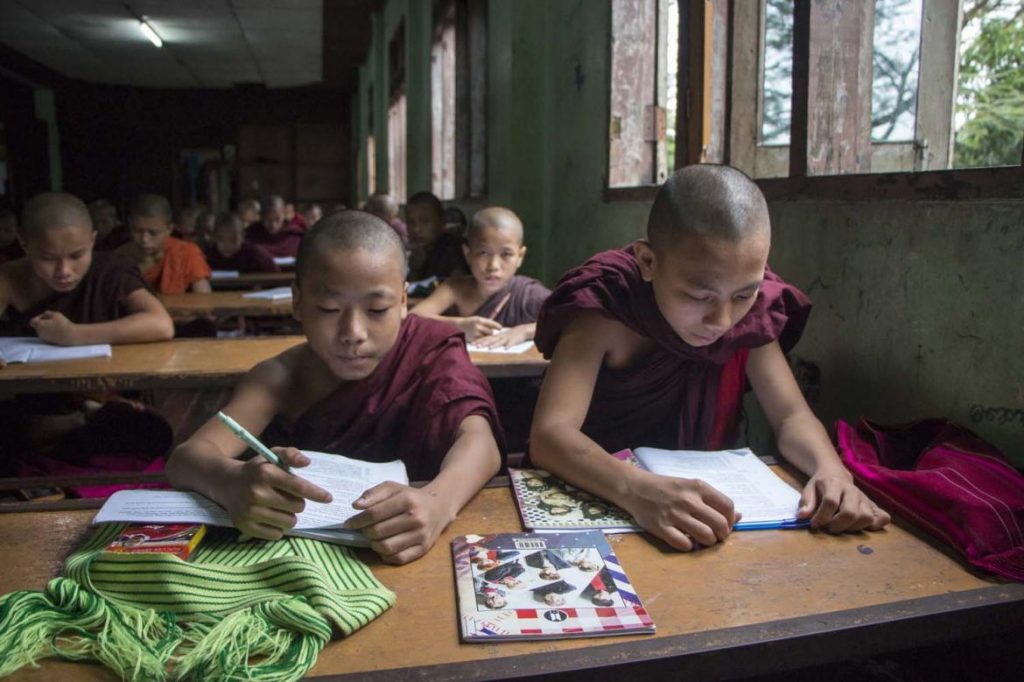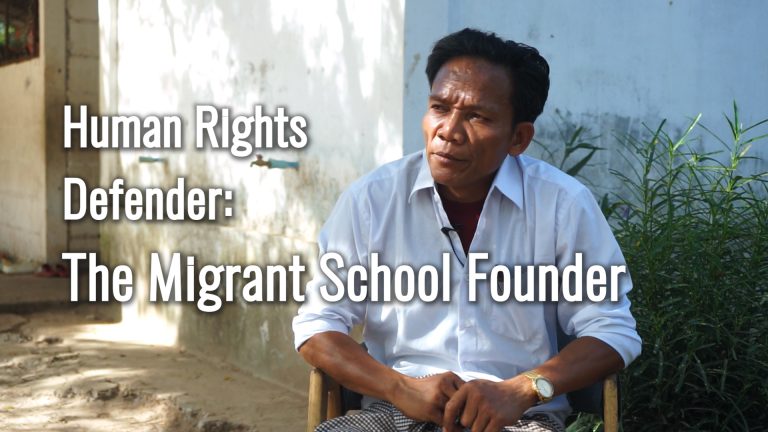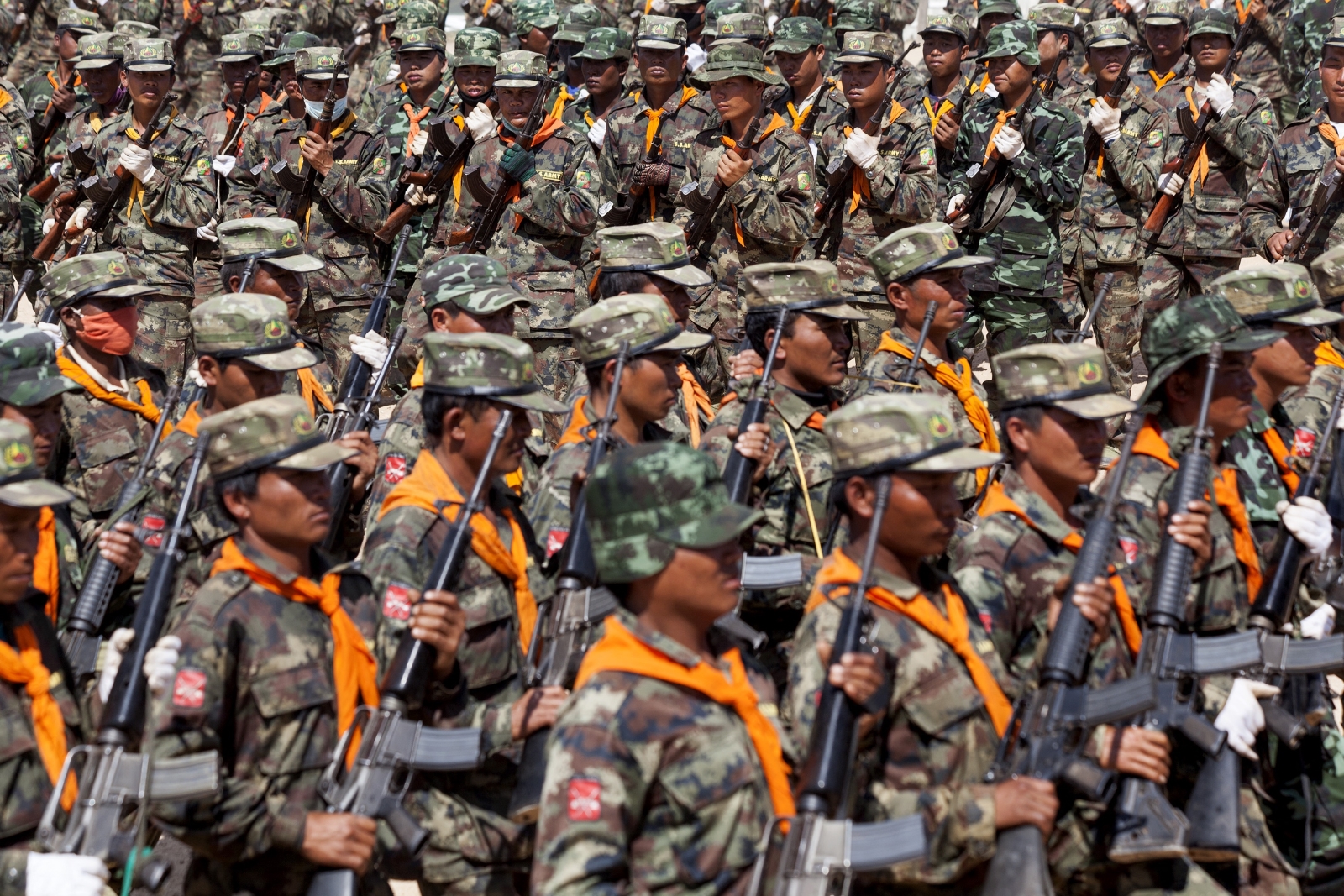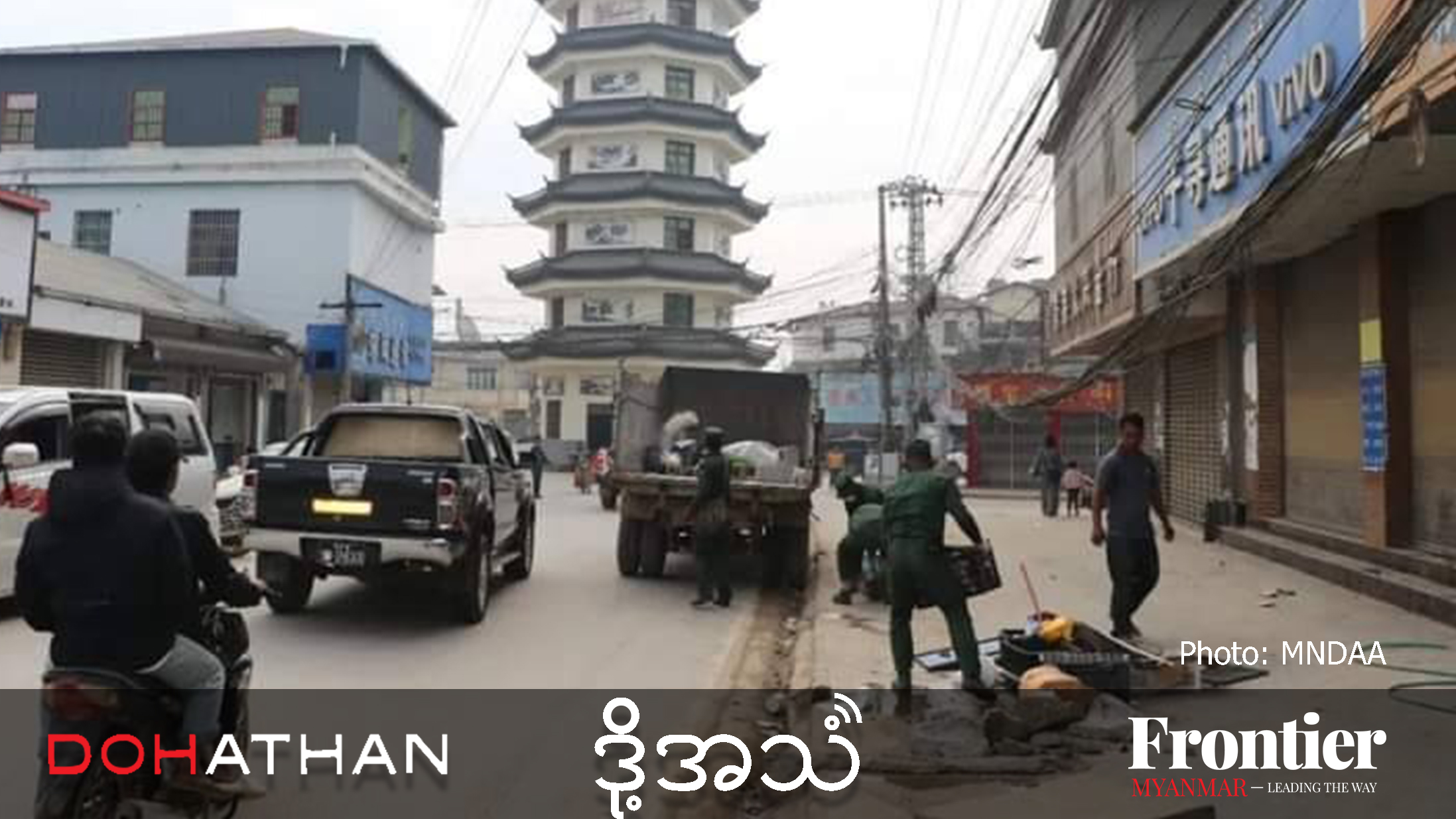Parents in conflict-torn regions are sending their children to monastic schools in Yangon, where they can be educated in safety but also often lose connection to their homelands.
By HEIN THAR | FRONTIER
PYINNYASARI hides her hands in her soft pink nun’s robes. She speaks slowly as she relates her story, keeping her face downcast.
Now 18, she was given her Pali name nine years ago, when she became a Buddhist nun: pyinnya means wisdom and sari means practice.
Before she joined the monastic school, she was called Lwe Naw. A member of the Ta’ang ethnic group, also known as the Palaung, she grew up in Maw Han village in Kutkai Township – an area of northern Shan State that has rarely known peace, and where civilians are often caught between the Tatmadaw and ethnic armed groups.
When she was five, Lwe Naw’s father was recruited by one of those groups and died in a battle. It was a hard life for her widowed mother and three siblings, and conflict clouded their lives with uncertainty.
Support more independent journalism like this. Sign up to be a Frontier member.
Lwe Naw’s mother sent her to a monastic school in Yangon, almost 1,000 kilometres to the south of Kutkai, so that she could receive an education in a safe environment. Lwe Naw became Pyinnyasari, who is now in the tenth standard at the Kalaywa Tawya monastery in Yangon’s Mayangone Township. She acts, talks and walks like a well-trained, veteran nun. She has also started to forget the Ta’ang words she used as a child.
She says she sorely misses her mother and younger brother but still considers herself fortunate to have been educated in a place far from armed conflict. “A lot of my friends [from home] wanted to come here. They said I was lucky,” she said. While she was happy being nun, she said she hoped to soon leave the Sangha, as the Buddhist monastic community is called, and become a teacher in the state school system.
Pyinnyasari’s teacher at Kalaywa Tawya is Wunnasari. She, too, is a Ta’ang who fled conflict in the northern Shan hills, arriving at the monastery 20 years ago. It has become a permanent home, where she oversees the education of younger nuns.
“They are safe under the umbrella of the Sasana [Buddhist religion] while they are being educated,” said Wunnasari. “They decide what they want to do only when they finish their education.”

Pyinnyasari, born with the Ta’ang name Lwe Naw, moved from northern Shan State to the Kalaywa Tawya monastic school in Yangon nine years ago. (Nyein Su Wai Kyaw Soe | Frontier)
Donning the yellow robe
Kalaywa Tawya is what’s known as a monastic school, or ba ka kyaung. Thousands of monastic schools operate throughout the country with the approval of the Ministry of Education and the Ministry of Religious Affairs and Culture. Although they are independent, they teach the national curriculum and their students sit the same exams as children at state-run schools. Since they don’t charge fees, the monastic schools rely on donations.
Though the government pays the teacher’s salaries, the amount they receive is negligible – K35,000 a month at primary, K45,000 at middle and K55,000 at high school level. Meanwhile, a teacher at a standard primary school can expect K180,000 a month. U Shwe Thein, 54, who teaches physics at Kalaywa Tawya, said, “With a salary this low, the work is basically voluntary.” He had been the headmaster of a state middle school in Yangon and chose to teach at the monastic school after retirement because he considered the work “noble”. He also found it “more than enjoyable than a headmaster’s life”.
For ethnic minority children such as Lwe Naw who are from war-torn parts of the country, monastic schools in Yangon are their best opportunity to both stay safe and attain an education. Some parents send their children to monasteries in Yangon because there is no school in their village, to ensure they cannot be recruited by armed groups, or because they are too poor to feed them. As a result, monasteries in Yangon are crowded with novice monks and nuns from Shan, especially Ta-ang, Pa-O and Shan children. Only a few of the children at the schools are from Yangon.
Mai Nyi Kham, a Ta’ang living in northern Shan’s Kyaukme Township, told Frontier by phone that he had sent his two sons to a monastic school in Yangon to avoid dangers that weren’t limited just to war. “I think my sons should not grow up in northern Shan State,” he said. “If they lived here, I would always worry about them getting addicted to drugs or dying in conflict.”
Children from ethnic minority areas are asked to sit a placement test to attend a monastic school, and should be aged between six and 20. But the strictest requirement for children attending a monastic school in Yangon is that they enter the Sasana and become a novice monk or nun.
Living in a big city like Yangon, where there are many donors, ensures that the children have enough food and good living conditions. Most Buddhists respect those who don the thingan, or “yellow robe” (so-called traditionally, though today the robes of monks and nuns are usually maroon and pink). This is regardless of whether they are young or old, where they have come from, their ethnicity and the language they speak.
Figures from the supervisory board for monastic education in Yangon Region show that in 2018 there were more than 280 monastic schools in the region, attended by about 80,000 novices and nuns.

On a wall in Kalaywa Tawya monastic school, older novices have put up a large map of Myanmar that they use to instruct younger novices in the sorrowful geography of the country’s armed conflicts. (Thuya Zaw | Frontier)
Sayadaw U Kuthala, who heads the supervisory board, estimates that about 70 percent of the novice monks and nuns studying at Yangon monastic schools – more than 50,000 in total – are ethnic minority children from northern Shan State. Most of the other students are from central Myanmar, Ayeyarwady Region and Rakhine State, he said.
“This is the easiest way for the ethnic children to receive an education. It costs nothing, and is very simple, with few requirements,” said Kuthala, who is also the founder of the Natmauk monastic school in Yangon’s Thaketa Township.
The escalation in conflict in northern Shan in the past five years has corresponded with a sharp increase in the number of monastic schools in Yangon. These schools have opened their doors to accommodate a big rise in the number of children whose families have been harmed, threatened or displaced by conflict between the Tatmadaw and groups such as the Ta’ang National Liberation Army and Shan State Army-North.
Supervisory board figures show that both the number of monastic schools in Yangon and the number of enrolled students has jumped by about 50 percent since 2014, when there were 190 schools with about 50,000 students.
Many of the children are from the northern Shan townships of Kyaukme, Namhsan, Namtu, Kutkai and Hsipaw, where thousands of villagers have been intermittently displaced by fighting.
Kuthala said most of the displaced children come to monastic schools in Yangon rather than other parts of the country because food and shelter is more readily available in and around the commercial capital.
Mandalay Region has more monastic schools but fewer students in robes, because, unlike in Yangon, it is not mandatory to become a novice or nun. There are 325 monastic schools in Mandalay, attended by 68,000 students, of whom only about 4,000 wear robes. Sayadaw U Nayaka, secretary of the Mandalay ba-ka schools supervisory board and founder of the famous Phaung Taw Oo monastic school in central Mandalay, said most of the Sasana and lay students are Pa-O, Palaung and Shan from northern Shan.
Kuthala said that because Mandalay already had a vast monastic community, with each monastery competing for donations from the public, it was more difficult for young novices to receive enough food in the northern capital. “Mandalay, for a city of its size, has too many members of the sangha,” Kuthala said.
This was why there were so many more young novices in Yangon, he said; ethnic novices can expect to receive plentiful offerings of food from the faithful in Yangon when they go on their morning alms round.
“If we go to about 15 houses, our alms bowl will be full of soon [food offerings], enough for our lunch,” said Koyin Wilatha, a novice at the Kalaywa Tawya monastic school. Koyin is the honorific for a novice monk.

Nuns at Kalaywa Tawya. (Nyein Su Wai Kyaw Soe | Frontier)
Than Shwe and the Wa children
Kalaywa Tawya is the biggest monastic school in Yangon. Its records show it houses nearly 900 novices and nuns, of whom more than 800 are Ta’ang, Pa-O and Shan. It is also known as the Narga Hline Gu monastery, because its compound contains the Narga Hline Gu Pagoda.
Kalaywa Tawya has played a prominent role in the development of monastic schools under reforms introduced by the former military regime. In 1993, the regime formed a monastic school supervisory committee under which monastic schools were accredited and required to teach the full national curriculum. Before then, monastery schools mainly taught Buddhist texts, and rarely taught other subjects. An objective of the 1993 directive was to contribute to the “development” of border areas of Myanmar by enabling ethnic minority children to acquire a formal education of a type rarely available where they lived.
Kalaywa Tawya was the first monastic school to be accredited by the government, said Sayadaw U Yuzana, who is in charge of the school because the head monk, Tipitakadhara Zargara, is old, unwell and confined to his bed. The elderly monk has received generous patronage from Senior General Than Shwe, who ruled Myanmar till 2011, alongside other important figures in the Tatmadaw and the military-linked business community.
Than Shwe, who had just taken over as head of the military junta, took a special interest in the school. A Tatmadaw helicopter flew in 16 orphans from the Wa autonomous region of Shan State to form the first batch under the new system, according to Yuzana. A donation from Than Shwe in 1996 funded the construction of a three-storey building, which made Kalaywa Tawya the biggest monastic school in Yangon.
Today, novices and nuns attend classes from primary to pre-university level. The novices attend a session in the morning before leaving the monastery to receive offerings on the streets of Yangon. Classes resume at midday and last until evening.
Than Shwe’s image at the entrance to the school honours his contribution as an important donor. A visitor might remark on the irony of a man held responsible for the mass displacement of civilians in border areas, via Tatmadaw campaigns, sponsoring the education of ethnic minority children who have fled the same violence.
When Wilatha, 17, first arrived at the school, he was terribly homesick. But life at home in northern Shan was dangerous, he said. The sound of fighting had often echoed in the hills around his Ta’ang village of Lweh Glay in Kyaukme Township. In 2013 his parents sent him to a monastery in Kyaukme town, but Wilatha left for Yangon in 2017 after an upsurge in fighting and forced recruitment made even this sanctuary feel insecure.
Novices such as Wilatha, who is now in the Ninth Grade, were in their late teens when they arrived in Yangon and know the grim realities of conflict. However, the very young novices understand little about the conflicts that displaced them. The older novices have tried to change that. On a wall in the main school building they have put up a large map of Myanmar that they use to instruct the younger novices in the sorrowful geography of the country’s armed conflicts, and to help them understand why they are living far from their families.
Where the map shows Kachin State, the older novices have written the acronym for the Kachin Independence Army; and over Shan State, “TNLA”, “RCSS” and “SSPP”, references to the Ta’ang National Liberation Army, Restoration Council of Shan State and Shan State Progress Party, the latter two being the political wings of the “southern” and “northern” Shan State armies. Over Rakhine State they have written “AA”, for the Arakan Army. The names of other ethnic armed groups are scrawled elsewhere on the map.
Yuzana tolerated this initiative, saying, “I think every novice and nun needs to learn about civil war. We don’t need to hide it from them.”

The compound of Kalaywa Tawya monastery in Yangon. (Thuya Zaw | Frontier)
Losing home
One stark consequence of the children being educated in Burmese far from home is that many of them lose the ability to speak the ethnic languages they grew up with.
“Because some of the ethnic children arrived in Yangon when they were very young they have lost the ability to speak their mother tongue,” said Kuthala. “They can’t communicate with their parents. Some of them don’t even remember their parents.”
The loss of mother tongues compounds a separation from families and ancestral communities that quickly becomes entrenched. Many of the older novices who have been in Yangon for many years said they were reluctant to return home because of the dangers of armed conflict and the possibility of being recruited by ethnic armed groups.
Pyinnyasari said that, in her nine years at the monastery, she had only visited her home village twice. She was very rarely in contact with her mother, she said, and did not even know her phone number.
Kuthala said Pyinnyasari’s estrangement from her family was common among the novices and nuns at Kalaywa Tawya. He said that many of the families could not afford the journey to Yangon to visit their children, and some were too poor to buy phones.
Often, the nuns and novices see their futures in Yangon, where many before them have attended university or joined the workforce. In doing so, they must forfeit the protection of the monastery, but several told Frontier they were eager to make their own lives the big city. Yuzana said only a few of the novices and nuns elect to remain in robes like Wunnasari.
Wilatha’s dream after he completes his monastic education is to become a famous singer. Once he becomes a layperson, he hopes to compete on the popular television programme “Myanmar Idol”. “But I will wait until my hair grows back,” he said, laughing.







